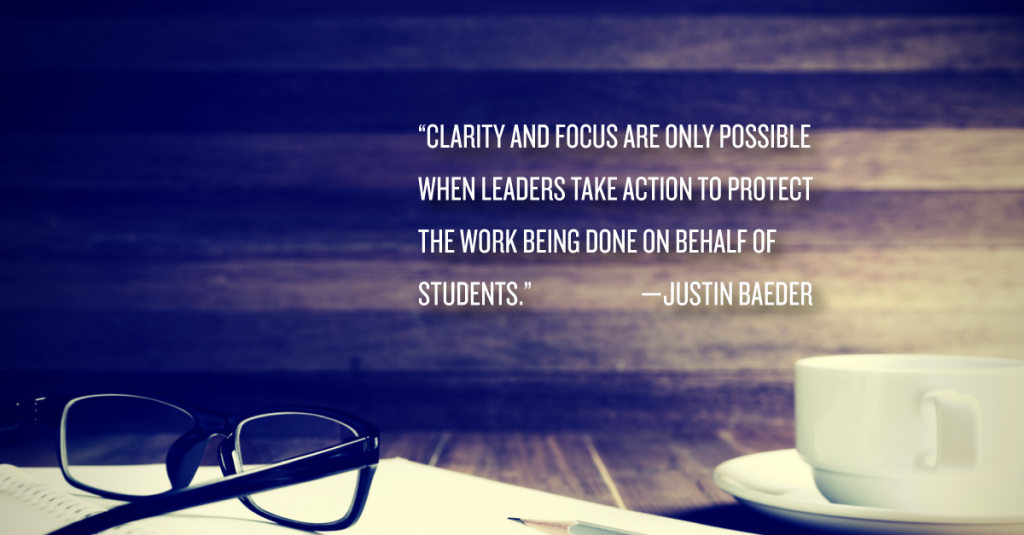If we want to achieve results for students, it's no secret that focus is essential.
Schools that chase too many rabbits—to paraphrase the old saying—often catch none of them.
To achieve sustained excellence, schools must have a clear vision, and pursue it single-mindedly (while also keeping everything else under control).
And if you want to bring about significant improvement in your school or district, you must establish a clear theory of improvement.
A theory of improvement is a set of predictions about what actions will bring about the desired improvement.
For example, your district may operate under the hypothesis that long-term, job-embedded professional development in literacy will result in improved student learning. Testing that hypothesis justifies substantial investments over the long term.
But even the most powerful improvement work faces a constant threat:
Distraction.
The Good Idea Proliferation Problem
We all want our schools to do the best job possible. We want to implement the best programs, the best curriculum, the best models.
We want to win the grants to bring in additional resources.
Our students need us to give them everything we can muster, so we're always striving for more.
At first, this can be a good thing. Who could argue against having better curriculum, instruction, support services, and other resources?
But over time, good ideas accrue, and as a system, it all starts to become unwieldy.
Let's say you love cats. (Maybe you don't, but bear with me for a moment.)
You might think having a cat is great, and having two cats could even be twice as good.
But a dozen cats? Fifty? A hundred?
Too much of a good thing can quickly become an unhealthy situation for everyone.
Of course, we know this, so our strategic plans tend to be relatively strategic and relatively focused.
But good ideas have the same problematic natural tendency as cats: they reproduce.
If you have a dozen cats, and you keep feeding them, soon you'll have hundreds.
And if you have lots of great programs and initiatives and ideas, and you keep feeing them with attention and resources, they'll proliferate.

Know Your Constraints
We tend to have a good sense of our financial constraints. If a great opportunity pops up, but it costs a thousand dollars per teacher, we're probably going to pass—or at least think about it for a long time before jumping in.
But opportunities that are costly in terms of time and attention can sneak in unnoticed.
This tendency is especially pernicious when it comes to teacher time, which we systematically undervalue.
Since teachers are salaried and don't get overtime—and since they already work far more than the hours they're technically paid for—we tend to treat their time as infinitely expandable.
This is both disrespectful to these professionals, and unwise from a leadership perspective. It creates what Peter Senge, in The Fifth Discipline, calls a “Shifting the Burden” dynamic.
Plainly speaking, when we ask teachers to do more of one thing, they must consequently do less of something else.
Something's got to give, and often, the “something” that suffers is planning, assessment, or collaboration—the core professional activities that occupy teachers' non-class time.
The same dynamic exists for leaders—the more issues we're dealing with, the more our core work suffers.
But we're not just constrained by the number of hours in the day—and this is why our willingness to work longer hours doesn't solve the problem.
One of our greatest constraints is decisional bandwidth.
Decisional Bandwidth
An organization's capacity for instructional leadership is defined as its ability to make and implement operational and improvement decisions.
That's my definition, and it's what frames all the work I do with schools and school leaders to build capacity.
And after engaging in this work for a number of years, I've noticed that we tend to recognize the limitations on our time to implement.
But—just as we undervalue teacher time—we undervalue the actual making of decisions.
Making the right decisions for our organizations is both critical and resource-intensive. It takes up precious meeting time, and tests the limits of our leadership capital and social capital. It creates conflict that must be overcome if we're to remain unified.
And on a personal level, decision making creates what psychologists call “decision fatigue” (which I'm sure you've felt after a long day of, say, teacher hiring interviews).
The bottom line? We have limited organizational bandwidth for making decisions. And every new program or initiative we take on has a hidden cost in future decisions we'll need to make along the way.

Strategically Saying No
There's only one way for schools to achieve focus in a world that seems to grow more complex by the day.
Leadership.
Distraction is nearly automatic. We get pulled in too many different directions by a multitude of forces.
Clarity and focus are only possible when leaders take action to protect the work being done on behalf of students.
And this protective work is essential, because without sustained attention to our core work, we'll stagnate:
[A]ny organized process naturally tends to decline to a chaotic state if we leave it alone. —Mike Rother, Toyota Kata, p. 12
In other words, if allow more and more priorities to take our eyes off the ball, we'll not only fail to improve our schools, but we'll fail to sustain the hard-won gains we've already achieved.
How can we create this focus?
Learn more in the exclusive courses available with our Principal Center Pro Membership.»
